Water damage or leakage behind baseboards can create an ideal environment for mold growth. This issue is more common than one might think. Millions of dollars are spent annually on mold remediation in the United States alone.
When wet baseboards are left unaddressed, they can become a breeding ground for mold. This poses serious health risks to occupants. Understanding the relationship between damp baseboards and mold is key for a safe and healthy living environment.
Key Takeaways
- Mold growth is facilitated by water damage or leakage behind baseboards.
- Wet conditions behind baseboards can lead to serious health risks.
- Prompt action is necessary to prevent mold growth.
- Regular inspection of baseboards can help identify issues early.
- Maintaining a dry environment is key to preventing mold.
Understanding the Relationship Between Wet Baseboards and Mold Growth
Moisture on baseboards can start a chain of events that leads to mold. When baseboards get wet or are in humid air, mold can grow.
How Moisture Affects Wooden Baseboards
Wooden baseboards are very sensitive to moisture. Water from flooding, leaks, or condensation makes them absorb moisture. This creates a perfect spot for mold to grow. Moisture control is key to stop wooden baseboards from getting damaged and mold from growing.
When wooden baseboards soak up moisture, they can warp, swell, and weaken. As they dry, they might crack. This makes the wood even weaker and gives mold more places to grow.
Ideal Conditions for Mold Development
Mold loves damp places with moisture, the right temperature, and food. Damp conditions behind baseboards are great for mold because there’s little air and water can collect.
- High humidity levels
- Presence of water due to leaks or condensation
- Poor ventilation behind baseboards
Knowing these factors helps stop mold. By controlling moisture and ensuring good air flow, homeowners can lower mold risk behind their baseboards.
Can Wet Baseboards Cause Mold in California? Signs, Causes, and Health Impacts
Moisture behind baseboards can lead to mold, which is harmful to health. It’s important to know the signs, causes, and health risks of mold behind baseboards in California. This knowledge helps in keeping your home safe and mold-free.
Common Signs of Mold Behind Baseboards
Spotting mold early can stop big problems and health issues. Look out for these signs:
- Visible Mold: Black spots or patches on the baseboards or nearby areas.
- Water Stains: Discoloration on walls or baseboards showing water leakage.
- Warping or Buckling: Moisture makes baseboards warp or buckle.
- Peeling Paint: Paint peeling or bubbling near baseboards hints at hidden moisture.
Common Sources of Baseboard Moisture
Knowing where moisture comes from helps prevent mold. Common sources are:
- Plumbing Leaks: Leaks from pipes behind walls or under floors cause moisture buildup.
- Condensation: High humidity leads to condensation on or near baseboards.
- Poor Drainage: Bad drainage outside can let water seep into the home, affecting baseboards.
- Flooding: Flooding events can soak baseboards, leading to mold if not dried properly.
Health Risks Associated with Baseboard Mold
Mold exposure can harm your health. The risks include:
- Respiratory Issues: Mold spores can make asthma and other breathing problems worse.
- Allergic Reactions: Mold can cause allergic reactions, like sneezing and skin irritation.
- Infections: Rarely, mold exposure can cause infections in people with weak immune systems.
To fix mold, you need to get rid of the mold and the moisture causing it. For serious mold, getting professional help is best. They ensure a complete clean-up and prevent mold from coming back.
Preventing and Addressing Mold from Wet Baseboards
To stop mold from growing behind baseboards, you need to control moisture and keep your home in good shape. Homeowners can prevent mold by fixing leaks fast, improving air flow, and quickly dealing with water damage.
Keeping moisture levels down is key to stopping mold. Use a dehumidifier in damp areas and make sure your home breathes well. Also, check for water damage and keep gutters clean to avoid moisture buildup.
If mold has already appeared, you might need a pro to fix it. They’ll remove moisture, clean or replace damaged parts, and stop mold from coming back. Knowing the dangers of wet baseboards and acting early can keep you and your home safe.
By tackling moisture issues and stopping mold, you avoid health problems and expensive fixes. Keeping up with home care and fixing water damage quickly can prevent mold. This makes your home safer and healthier for everyone.
Contact Disaster Kleenup Specialists today for expert mold and water damage services in California!

